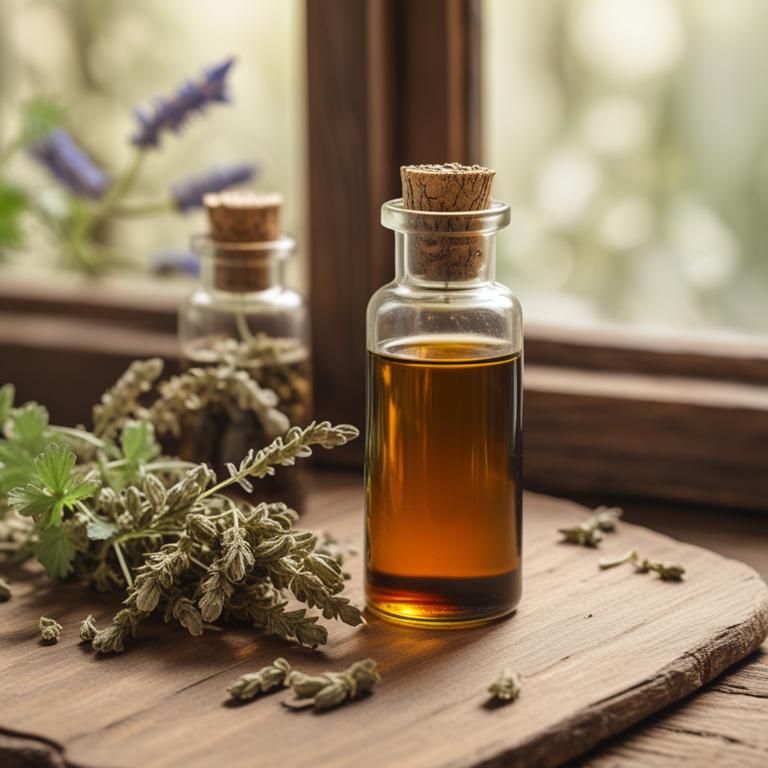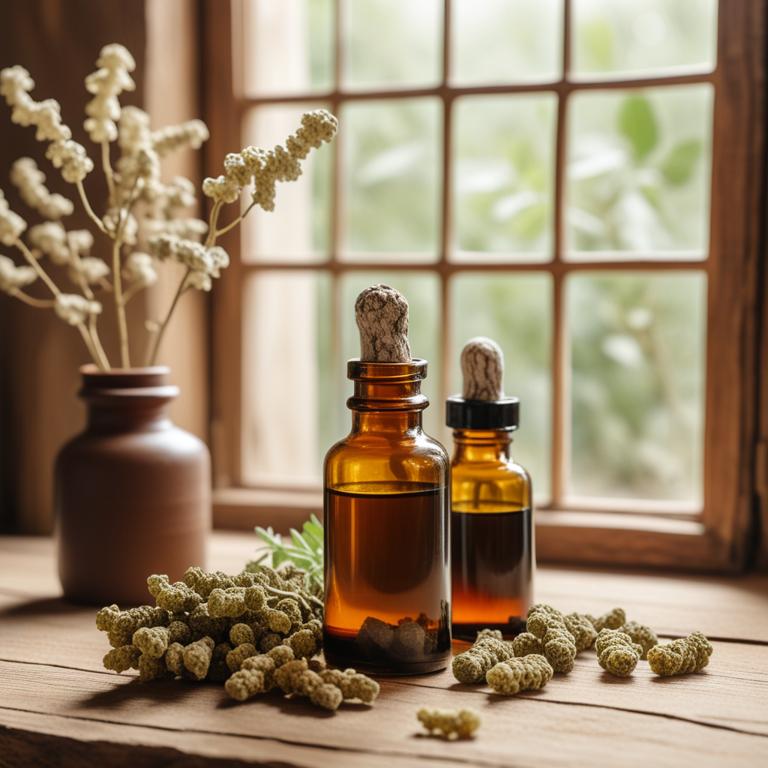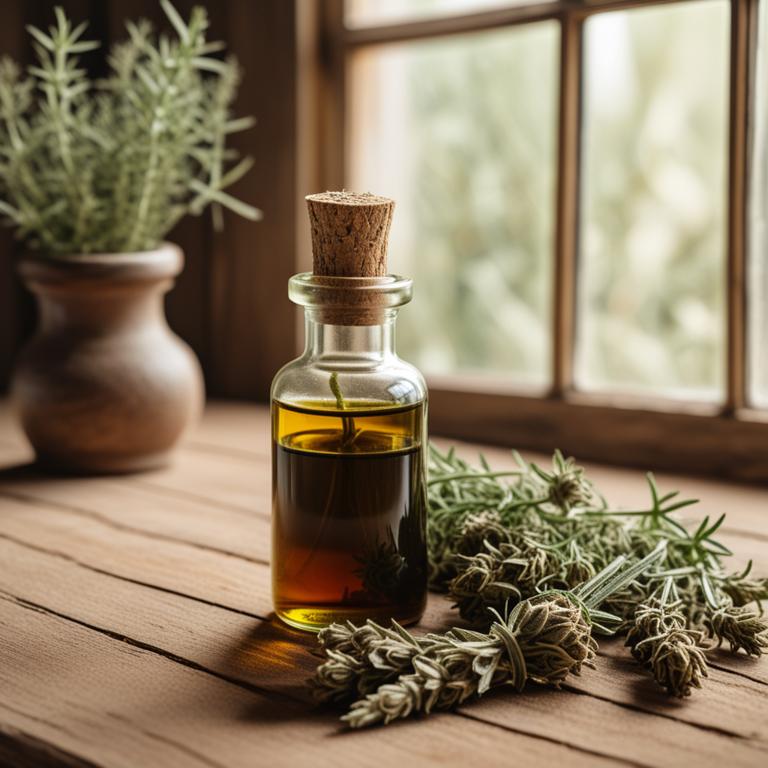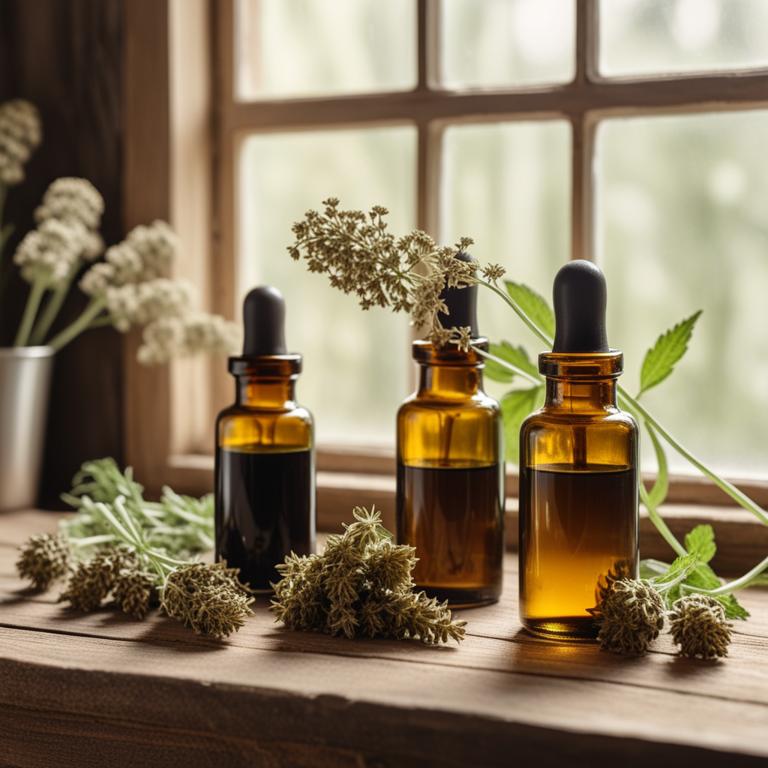9 Best Herbal Tinctures For Stiff Neck

Herbal tinctures for stiff neck are highly concentrated liquid extracts made from plants and herbs, typically used to alleviate muscle and joint pain associated with this condition.
The benefits of using herbal tinctures to treat stiff neck include reduced inflammation, improved circulation, and relaxation of tense muscles.
Examples of herbal tinctures that can be used to treat stiff neck include Willow bark, which contains salicin and has anti-inflammatory properties, and Ginger, which is known for its warming and analgesic effects.
Other effective herbal tinctures include Turmeric, which contains curcumin and has potent anti-inflammatory and antioxidant properties, and Eucalyptus, which has decongestant and anti-inflammatory properties that can help to relieve tension and promote relaxation.
According to "The Cochrane database of systematic reviews", tinctures for stiff neck, specifically Compound Qishe Tablets and Compound Extractum Nucis Vomicae, may provide relief for individuals experiencing chronic neck pain with radicular signs or symptoms.
Below there's a list of the 9 best herbal tinctures for stiff neck.
- 1. Zingiber officinale tinctures
- 2. Boswellia serrata tinctures
- 3. Rosmarinus officinalis tinctures
- 4. Valeriana officinalis tinctures
- 5. Ginkgo biloba tinctures
- 6. Curcuma longa tinctures
- 7. Hypericum perforatum tinctures
- 8. Lavandula angustifolia tinctures
- 9. Cinchona officinalis tinctures
Also you may be interested in...
TODAY'S FREE BOUNDLE
Herb Drying Checklist + Herbal Tea Shopping List + Medicinal Herbs Flashcards
Enter you best email address below to receive this bundle (3 product valued $19.95) for FREE + exclusive access to The Aphotecary Letter.
$19.95 -> $0.00
1. Zingiber officinale tinctures

Zingiber officinale tinctures, derived from the rhizome of the ginger plant, have been traditionally used to treat the stiff neck ailment due to its anti-inflammatory and analgesic properties.
The bioactive constituents of Zingiber officinale tinctures, including gingerols and shogaols, help to reduce muscle spasms and alleviate pain associated with stiff neck.
These constituents work by inhibiting the production of pro-inflammatory enzymes and blocking the action of pain mediators, thereby providing relief from stiffness and discomfort.
The benefits of using Zingiber officinale tinctures to treat stiff neck include reduced pain and inflammation, improved range of motion, and enhanced overall well-being.
2. Boswellia serrata tinctures

Boswellia serrata tinctures have been traditionally used to treat the stiff neck ailment by reducing inflammation and alleviating pain due to their anti-inflammatory and analgesic properties.
This herbal preparation helps to treat stiff neck by inhibiting the production of pro-inflammatory enzymes and promoting relaxation of the muscles.
The bioactive constituents of Boswellia serrata, including boswellic acids and volatile oils, contribute to its therapeutic effects by blocking the actions of inflammatory mediators and improving blood flow to the affected area.
The benefits of using Boswellia serrata tinctures to treat stiff neck include rapid relief from pain and stiffness, improved range of motion, and enhanced overall well-being.
Related Study
According to "Phytotherapy research : PTR", Boswellia serrata tinctures may be effective in reducing stiffness as they were found to be more effective than both placebo and valdecoxib for improvement of physical function, which may indirectly indicate a reduction in stiffness associated with conditions like osteoarthritis, although the study did not explicitly state the effect of Boswellia serrata tinctures on stiff neck.
3. Rosmarinus officinalis tinctures

Rosmarinus officinalis tinctures have been used to treat stiff neck ailment due to their anti-inflammatory and analgesic properties, which help to reduce pain and swelling in the affected area.
The bioactive constituents of Rosmarinus officinalis tinctures, including rosmarinic acid and carnosic acid, exhibit potent antioxidant and anti-inflammatory activities, contributing to their therapeutic effects.
By reducing inflammation and promoting relaxation, Rosmarinus officinalis tinctures can help to alleviate the stiffness and discomfort associated with this ailment, promoting faster recovery and improved range of motion.
The benefits of using Rosmarinus officinalis tinctures to treat stiff neck include reduced pain and inflammation, improved flexibility, and enhanced overall well-being.
4. Valeriana officinalis tinctures

Valeriana officinalis tinctures have been traditionally used to treat stiff neck, a condition characterized by muscle tension and limited range of motion.
The relaxing and anti-inflammatory properties of this herbal preparation help to soothe the affected muscles and reduce pain and discomfort.
The bioactive constituents of Valeriana officinalis, including valerenic acid, valerenol, and isovalerenol, have been found to interact with the GABA receptors in the brain, promoting relaxation and reducing muscle spasms.
Regular use of Valeriana officinalis tinctures can provide relief from stiff neck and improve overall neck mobility, making it a popular natural remedy for this condition.
5. Ginkgo biloba tinctures

Ginkgo biloba tinctures are often used to treat the stiff neck ailment, thanks to their anti-inflammatory and antioxidant properties that help to reduce muscle tension and improve blood circulation to the affected area.
The bioactive constituents of ginkgo biloba, including flavonoids and terpenoids, work together to inhibit the production of pro-inflammatory mediators and promote relaxation of the neck muscles.
By reducing inflammation and promoting relaxation, ginkgo biloba tinctures can help to alleviate the pain and stiffness associated with a stiff neck, improving range of motion and overall mobility.
The benefits of using ginkgo biloba tinctures to treat a stiff neck include natural and non-invasive relief from pain and inflammation, without the risk of side effects associated with pharmaceutical medications.
Related Study
According to "American journal of health-system pharmacy : AJHP : official journal of the American Society of Health-System Pharmacists", Ginkgo biloba tinctures may potentially be safe for use in alleviating stiff neck.
6. Curcuma longa tinctures

Curcuma longa tinctures, derived from the root of the turmeric plant, have been traditionally used to treat stiff neck ailments due to their anti-inflammatory and pain-relieving properties.
The bioactive constituents present in Curcuma longa tinctures, including curcumin, demethoxycurcumin, and bisdemethoxycurcumin, help to reduce inflammation and alleviate pain in the neck area.
These compounds have been shown to inhibit the production of pro-inflammatory enzymes and cytokines, which contribute to the development of stiff neck, thereby promoting relaxation and flexibility in the neck muscles.
Regular use of Curcuma longa tinctures can provide relief from stiff neck, promote joint mobility, and reduce the risk of chronic pain, making it a valuable natural remedy for this common ailment.
7. Hypericum perforatum tinctures

Hypericum perforatum tinctures, derived from the St. John's Wort plant, have been traditionally used to treat stiff neck ailments due to their anti-inflammatory and analgesic properties.
The bioactive constituents, including hyperforin and hypericin, help to reduce pain and inflammation by inhibiting the production of pro-inflammatory enzymes and promoting relaxation in the muscles.
As a result, Hypericum perforatum tinctures can provide relief from stiff neck pain, improve range of motion, and promote overall well-being.
The benefits of using Hypericum perforatum tinctures for stiff neck treatment include reduced pain, improved mobility, and a decrease in muscle tension, making it a popular herbal remedy for this common affliction.
8. Lavandula angustifolia tinctures

Lavandula angustifolia tinctures have been traditionally used to treat stiff neck ailments due to their anti-inflammatory and analgesic properties, which help to reduce pain and swelling in the affected area.
The bioactive constituents of Lavandula angustifolia tinctures, including linalool and linalyl acetate, contribute to its therapeutic effects by modulating the body's response to pain and promoting relaxation.
These herbal preparations can help to treat stiff neck by relaxing the muscles, reducing muscle spasms, and improving range of motion.
The benefits of using Lavandula angustifolia tinctures to treat stiff neck include reduced pain and inflammation, improved sleep quality, and enhanced overall well-being.
9. Cinchona officinalis tinctures

Cinchona officinalis tinctures have been traditionally used to treat the stiff neck ailment due to their analgesic, anti-inflammatory, and antipyretic properties.
The bioactive constituents, such as quinovic acid glycosides and alkaloids, help to reduce muscle spasms, relieve pain, and ease inflammation in the neck and surrounding areas.
By reducing inflammation and relaxing tense muscles, Cinchona officinalis tinctures provide relief from the stiffness and discomfort associated with this condition.
The benefits of using Cinchona officinalis tinctures to treat stiff neck include natural pain relief, reduced inflammation, and improved range of motion.